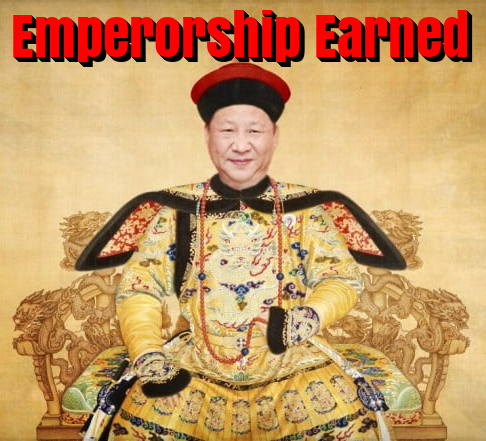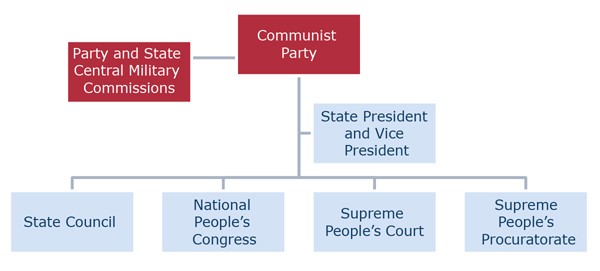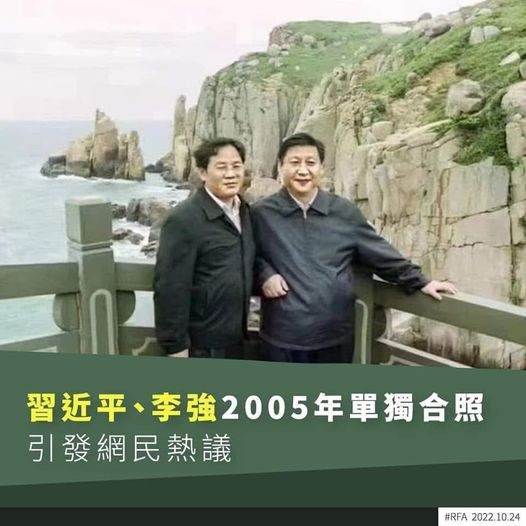The top Chinese leader is an emperor. The emperorship is earned and it is good for one person and one generation only. Three highlights:
- He (or she) is an emperor because he has absolute power, just like a traditional Chinese emperor did.
- The emperorship is earned because any Chinese can have it, via hard work and some luck.
- The emperorship is good for one person and one generation only, because it cannot be passed along via the bloodline (or marriage)!
1. China’s one-party system
The image below highlights China’s one-party system.
As you can see, the Chinese Presidency is not the top job in China. Rather, the General Secretary of the CPC (Communist Party of China) is!
Throughout this century so far, the CPC’s General Secretary has served as the Chinese President (and vice versa). So, they are practically the same person (aka the “top Chinese leader”).
Because there is no term limit to the CPC’s General Secretary, it was not a big deal for China to remove the term limit on the Chinese Presidency from the Chinese Constitution. For more, read Will Xi become Mao?
2. China’s top leaders
The image below highlights (1) the CPC hierarchy and (2) the seven-member CPC Politburo Standing Committee – China’s top-7 leaders. All seven are self-made men, with remarkable achievements climbing up along the CPC hierarchy. For more, read Wikipedia – CPC’s Politburo Standing Committee.
3. The top Chinese leader
Two most basic and challenging questions and answers …
First off, “is an emperor-like figure indispensable for China?”
My answer is yes. The key reason: Chinese civilization of the past 5,000 years has heavily relied on wise Emperors. Besides, what is the alternative – Democracy? Read American democracy: what is it and what’s wrong with it?
Secondly, “how should this emperor-like figure come by?”
Maybe an earned emperorship is just the way to go …
4. How is the emperorship earned?
Climbing up the CPC hierarchy is very much like climbing up the corporate ladder in America (e.g., GE). Two basic elements:
- You must have the ability.
- You’d better follow the right leaders – They pull you up when they move up, which is often the fastest way to move up.
The image below highlights (in Chinese) how Xi’s entire management team in Zhejiang, where he served as the governor 2003-2007, is now by his side in Beijing.
The image below is a photo of Xi and Li Qiang (China’s #2 and the next Prime Minister) in 2005.
So, it is nice to work for a winner!
The image below shows Xi, as the General Secretary of the 2017 CCP Politburo Standing Committee, was accompanied by three old classmates from decades ago.
Finally, for Xi’s successor, watch this guy – Beijing mayor Chen Jining in ‘surprise’ promotion to top job in Shanghai.
5. Summary
Governance is hard.
The image below highlights the essence of China’s meritocracy-based autocracy.
Do not underestimate this new Chinese [autocratic] system!
Although this system has been in existence for a few decades, more as an experiment than anything cast in stone (e.g., the term limit), it has taken China some 200 years to come to this stage, actually! Most importantly, this system looks awfully promising – The image below highlights the key difference between China and America today.
For more, read History 2.0 – China’s Comeback vs. America’s Decline.
6. Closing
As Professor Jeffrey Sachs correctly pointed out (see video at the end of this post), Chinese governance today is very much like it was in the Han dynasty: a meritocracy-based bureaucracy!
Here is a critical difference between now and then: the emperorship is earned now vs. inherited then!
For more, read Toward an ideal form of government.
Now, please sit back and enjoy the video below.












